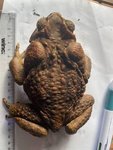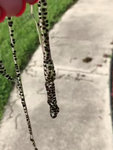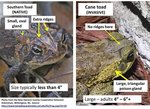LABELLE- As usual for this rainy time of year, cane toads are being spotted throughout LaBelle. Some are so large, growing up to nine inches, they are causing some newer residents to panic …
Join our family of readers for as little as $5 per month and support local, unbiased journalism.
Already have an account? Log in to continue. Otherwise, follow the link below to join.
Please log in to continue |



LABELLE -- As usual for this rainy time of year, cane toads are being spotted throughout LaBelle. Some are so large, growing up to nine inches, they are causing some newer residents to panic, asking what to do with these invasive and poisonous toads.
First introduced into Florida to control agricultural pests in sugar cane fields in the 1930s and 40s, cane toads do not have any predators to control their populations here in South Florida. They tend to become more active in the rainy season, which is why they are being spotted in LaBelle.
“The cane toad, also known as the bufo, giant or marine toad, is a large, nonnative amphibian that has been introduced into Florida,” said local herpetology enthusiast, Jack Boles. “They are an invasive species and are also poisonous to most animals that try to lick, bite, or eat them.”
Boles is often found helping locals remove these toads from their property.
According to the Florida Fish and Wildlife Conservation Commission, “This species of toad is not protected in Florida, except by anti-cruelty law, and can be removed from private property and humanely killed year-round with landowner permission. Captured cane toads may not be relocated and released.”
Cane toads are reddish-brown to grayish-brown with a light-yellow or beige belly and can be uniform in color or have darker markings around the body. They have enlarged glands behind the eyes, which angle downward onto the shoulders. The glands secrete a potent milky-white toxin (bufotoxin) as defense against predators including domestic pets.
“My sweet pup licked one of these and spent several nights in the emerge vet clinic. She almost died. It was very expensive, too,” said Marcia Colley, a newer LaBelle resident. “We are so much more aware and careful now, always keeping an eye out, making sure we get them removed and euthanized, from around our property.”
Cane toads generally range in size from 6 to 9 inches in length. They can be confused with the native southern toad, however, adult cane toads are much larger than adult southern toads which only grow to a maximum of approximately 3 to 4 inches.
“The humane way to get rid of cane toads, recommended by the University of Florida, is to use gloves when handling the toad and rub or spray the toad with 20% benzocaine toothache gel or sunburn spray. In a few minutes, it will become unconscious,” Boles said. “Put the toad in a sealed plastic bag in the freezer for 24-48 hours to ensure it is humanely euthanized. Once the toad is dead, dispose of it in the trash; do not bury it.”
For more information about cane toads, visit the FWC website: https://myfwc.com/wildlifehabitats/profiles/amphibians/cane-toad/